Despite An Up and Down Season, Derrick Pouliot Deserves Another Shot in the Top-Six

By Harman Dayal
5 years agoThe greatest beneficiary of Quinn Hughes’ decision to return to the University of Michigan may just be Derrick Pouliot.
Quite frankly, it’s difficult to fathom a scenario where Troy Stecher, Derrick Pouliot and Quinn Hughes would have made up half of the Canucks’ defence group entering the 2018/19 season. Removing Hughes from the equation subdues the defence logjam and exacerbates the need for a puck-moving offensive defenceman of Pouliot’s nature. Whether Pouliot fits that role long-term is questionable, though in the interim he’s the best option the Canucks have. And if his performance this season serves as any indication, the team would be wise to give him another chance in the top-6.
| Player | GP | G | A | P | CF% |
| Derrick Pouliot | 71 | 3 | 19 | 22 | 50.1 |
At 24-years-old, what you see is what you get with Derrick Pouliot. Unfortunately, it’s difficult to pinpoint precisely what the team has in the former first-round pick after an inconsistent season that featured just as many ups as it did downs.
Fortunately, aggregate data for the season paints a fairly accurate picture of both the value and shortcomings that Pouliot brings to the table with his skillset.

Number within brackets indicates ranking among Canucks defenders(minimum 100 minutes TOI) in each specified category
The question was never if Pouliot was good enough with the puck to make it as an NHL defender, but rather if those strengths could outweigh his flawed own zone play. As it pertains to his defending, the simple fact that he wasn’t a complete disaster this year constitutes a step in the right direction. In this case, Pouliot suppressed shot attempts at a better rate than any other Canucks’ defencemen, though the team’s high danger rate suggests that quality was an issue. In other words, while the team excelled at preventing the number of shot attempts allowed with Pouliot deployed, a significantly higher proportion of those attempts came from dangerous scoring areas. Such an assertion is corroborated by Micah McCurdy’s shot map visualization.
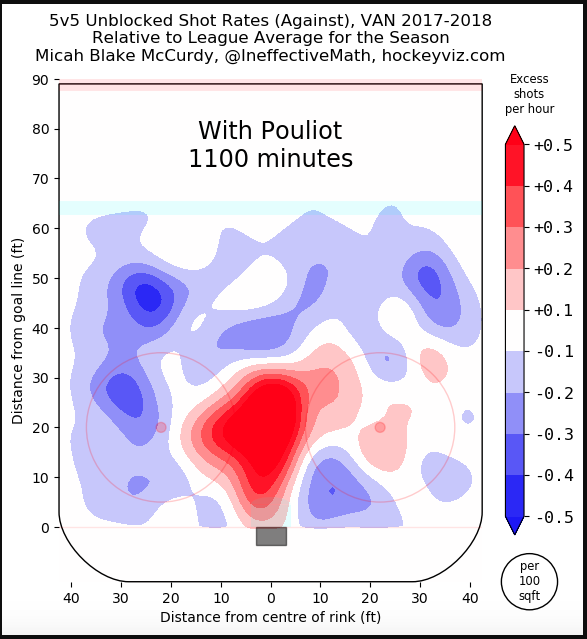
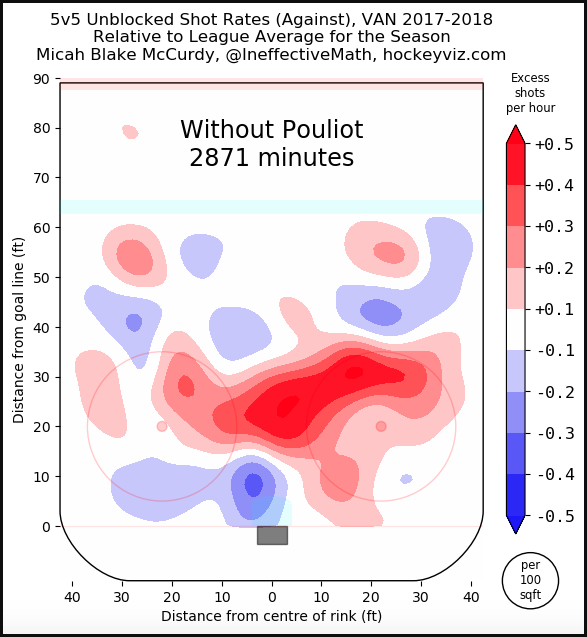
As is always the case, context is key and in this regard, Pouliot certainly received no favours. It’s true that he faced easier competition than most on the team, but the consensus from the analytics community remains that teammate quality is a more important factor given its more constant state. By that virtue, one would be within their rights to wonder if Pouliot would have fared better defensively without Michael Del Zotto as his most common partner. If Pouliot’s performance away from him holds any value, the answer’s an equivocal yes.

Data courtesy Natural Stattrick; xGF% pairing data via Corsica. Green indicates better performance relative to partnership; red indicates worse.
Pouliot’s on-ice results improved dramatically away from Del Zotto, while the latter’s play stayed more or less the same regardless of Pouliot’s presence. Most telling is that Pouliot conceded five fewer scoring chances per hour when on the ice with any defence partner not named Del Zotto.
This isn’t an indictment on Del Zotto, but rather evidence that it’s unwise to pair two defensively lacking blueliners together; with results showing that the pairing hurt Pouliot far more than it did Del Zotto. Moving forward, it’s a sign that perhaps Pouliot can deliver a better aggregate defensive showing with a more appropriate partner.
One key figure that you’ll notice missing is Pouliot’s raw goals against rate, which at 2.79 per 60 minutes of five-on-five play ranks last among Canucks’ defenders. It’s a paltry rate to be sure, but it bears mentioning that Pouliot suffered from the 24th lowest on-ice save percentage among defencemen who played at least 500 minutes in the league. Research into the matter of on-ice save percentages suggests that anomalies likely derive from poor luck rather than substandard defending in the vast majority of cases.
Given that Pouliot’s on-ice save percentage hasn’t been an issue in the 67 NHL games that he suited up in prior to joining Vancouver, I’m inclined to believe that it’ll normalize over time. I’m especially confident in that belief because expected goal models and shots are better predictors for future scoring than goals themselves — both shares(CF%, xGF%) by which Pouliot shines brightly relative to the team.
Much like it is with Pouliot’s defensive play, his offensive performance is more complex to tackle than one might think. For starters, seven of Pouliot’s even-strength points came via secondary assists. Research conducted by analytics expert Eric Tulsky theorizes that these assists are largely random and unrelated to one’s talent or actual influence on a goal. This is bad news for Pouliot as refining his production to only include primary points leaves him with just five at even-strength — only one more than Erik Gudbranson. In fact, Pouliot’s five-on-five primary points per hour rate ranks second-last among Canucks’ blueliners and 194th out of 212 league-wide defenders.
Adding a layer of confusion is that Pouliot actually generated shot assists at a rate commensurate with the top 15th percentile of league defenders according to Ryan Stimson’s passing project.
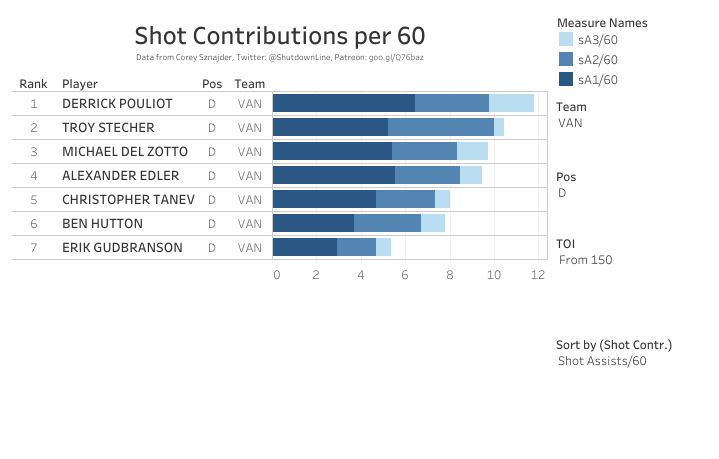
So why was Pouliot unable to register primary points during five-on-five play? Well, for one the Canucks converted on just 6% of their shots with Pouliot deployed — a conversion rate that slots Pouliot 16th lowest out of that same group of 212 NHL defencemen. The difference between Pouliot and some of the other rearguards near the bottom of the pile is that the team frequently generated scoring chances with Pouliot on the ice.
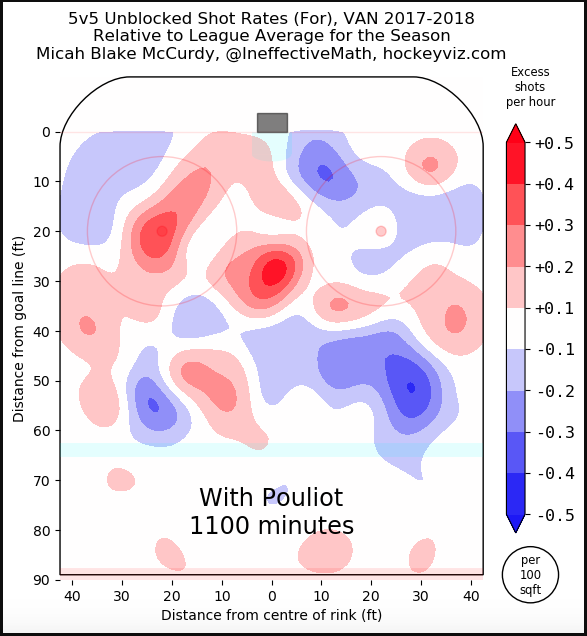
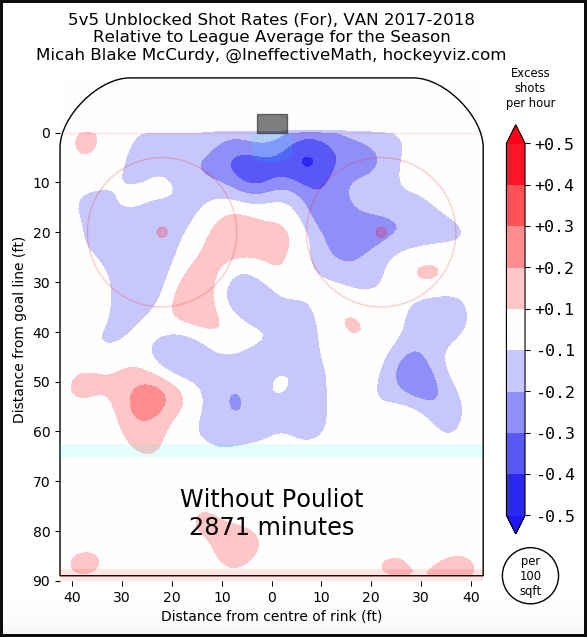
While his even-strength production leaves doubt, there’s no question that Pouliot excelled at manning the second power-play unit. His primary points rate on the man advantage eclipses Alex Edler’s by more than half a point per hour, despite the fact that the latter had more talent to work with on the first unit.
Where Pouliot’s individual contributions become easier to quantify is with his work in transition. Starting from the defensive zone, Pouliot did an excellent job of exiting the zone with possession of the puck — his 41% success rate topping the Canucks’ defence corps in Corey Sznajder’s sample. Unfortunately, Pouliot also developed a nasty habit of turning the puck over; failing to exit the zone 29.3% of the time he gained possession in his own zone. For reference, that failure percentage is only marginally better than Luca Sbisa’s disastrous turnover mark from 2016/17. It’s clear that Pouliot has the raw skills to be an effective puck mover, but he needs to work on processing the game and making safer decisions.
On the flipside, an area that stood out as an undeniable success was Pouliot’s proficiency at preventing controlled offensive zone entries.
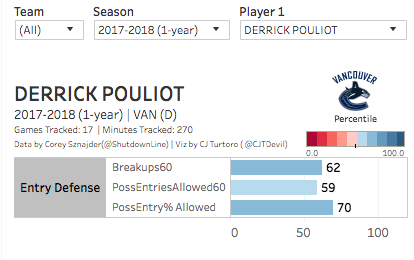
Data via Corey Sznajder; visualization courtesy CJ Turtoro
In January, I pegged Pouliot’s ability to defend the rush as a chief reason for his defensive success to that point in the season. Back then, I didn’t have the microdata to support my theory, but now that it’s available, it’s evident that it aligns with my previous faith in his anticipation, gap control, and adept stickwork. All those qualities were flashed in the first three clips of the video compilation I made around the time of that article.
Failed to load video.
Pouliot’s plaudits in transition are a big reason why the Canucks were able to control possession and tilt the shot clock in the right direction with the 24-year-old on the ice. The last bit of that assertion is part of the reason why Pouliot owns the second best goals above replacement(GAR) mark among Canucks’ defencemen.
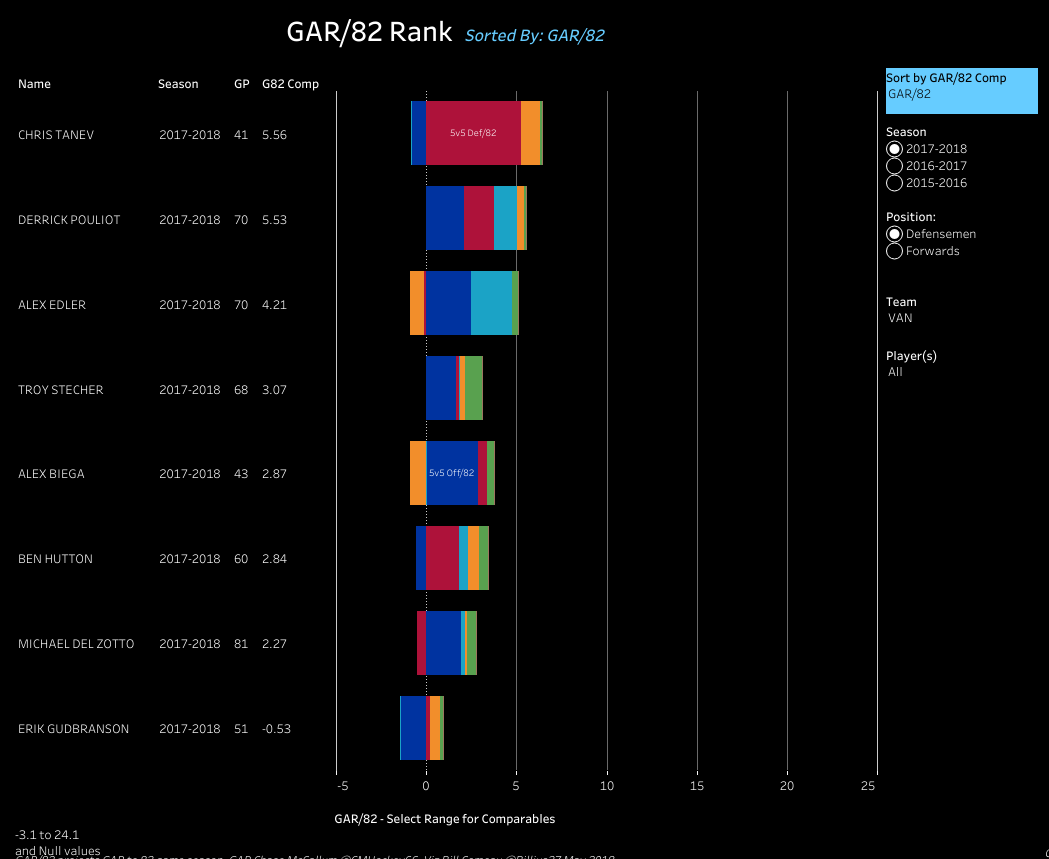
GAR data courtesy Chace McCallum, visualization via Bill Comeau
For those unfamiliar, GAR is a single, composite figure that takes a multitude of raw and on-ice metrics into account in an attempt to determine one’s net two-way impact relative to a replacement level player. Pouliot’s ranking among this group says more about the state of the Canucks’ backend than it does about the player himself, but it’s clear based on the data we’ve explored in this piece that the Canucks control play notably better with Pouliot on the ice than with him off.
Where Should Pouliot Slot Into the Top-Six Moving Forward?
So we’ve established that Pouliot deserves another shot in the top-six, but where exactly does he slot in and who should he play with?
One of the best uses for training camp is trying new line combinations and defence pairings heading into the regular season. Based on last season’s results, there are a few partners that Pouliot should audition alongside.

Alex Biega coupled with Pouliot to drive play remarkably well on the bottom pairing — owning a 50% or higher share of shot attempts, scoring chances, expected goals and actual scoring. Biega won’t feature in the top-six barring unforeseen circumstances, so it’s better to shift our focus to the other two names on the list.
32-year-old Alex Edler could prove to be a steady partner for Pouliot, with the latter’s aggressive neutral zone defending complementing Edler’s more passive approach. The raw on-ice numbers may not bear that out at first glance, though they’re more than respectable after accounting for their deployment as the team’s first-pairing following injuries to right-handed defencemen Chris Tanev and Troy Stecher. Most interesting about this situation is that Edler’s play suffered precipitously away from Pouliot.

It’s unlikely the two are reunited as it would require moving Pouliot to his off side and consequentially forcing one of Tanev, Stecher, or Gudbranson out of the lineup.
Speaking of Gudbranson, he looks to make the most sense as Pouliot’s partner given the likely construction of the rest of the defence corps. If we’re to trust the on-ice stats the duo posted in the limited time they spent together last season, they could prove to form a sound bottom pairing combination moving into the 2018/19 season. That’s all the Canucks can really hope for after a preceding campaign that saw the team cycle through various combinations with little success.
Author’s note: Since this article went well beyond the scope of a typical year in review piece, I decided it deserved its own standing. Given the article’s analysis of Pouliot’s play this year, there will be no additional year in review article for him.
Recent articles from Harman Dayal





